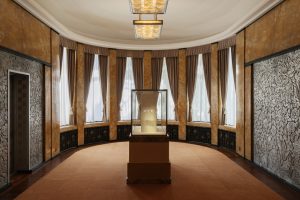Exploring the Possibility of a Mode of Sculpture that Contains Unseen Dimensions Half-hidden from View
"Body of the Gaze: Semi-Sculpture" by Shigeo Toya will be held at ShugoArts from Saturday 18 October to Saturday 22 November 2025. Toya’s work on the “Body of the Gaze” series has been ongoing since 2019. This time, the new works “Body of the Gaze: Semi-Sculpture” will be presented.
In Body of the Gaze: Semi-Sculpture, unveiled for the first time in this exhibition, Toya applies the prefix “semi-” to sculpture. What is the sculptural conception underpinning this approach? Relief existed before the golden age of sculpture in ancient Greece, and the standard view in modern Western art history holds that the process was a forward-moving evolution, advancing “from relief to sculpture.”

Shigeo TOYA, Body of the Gaze ‒ Accumulation, 2021, wood, wood ash, acrylic, 142x171x201cm (a set of 13 pieces)
Toya’s concept of “semi-sculpture” reverses this trajectory, moving instead from sculpture to relief. However, he is not pursuing a return to the primitive relief of the pre-Greek era. What he envisions with semi-sculpture is the possibility of a mode of sculpture that contains unseen dimensions half-hidden from view.
Also on view, and offering entry points to the world of Body of the Gaze: Semi-Sculpture, are Falling (1992), one of Toya’s best-known works, and the large-scale drawing Visions of Woods (2001).
Shigeo Toya
Shigeo Toya (b. 1947) endeavored to reconstruct sculpture following the deconstruction of the medium by the Minimalists and the Mono-ha movement. And in the 1970s, Toya began to explore sculptural principles and structures through a constant awareness of human existence. He embraced the achievements of both Western sculpture, stretching from cave painting to ancient Greece and Alberto Giacometti, and Japanese sculpture, ranging from the 17th-century Buddhist monk Enku to the early 20th-century artist Heihachi Hashimoto. At the same time, Toya arrived at a unique view of sculpture as an “accumulation of gazes,” and while showing astonishing groups of sculptures that transcended Mono-ha, he came to occupy a place as one of Japan’s preeminent sculptors.
Toya showed his work in the Japan Pavilion at the 1988 Venice Biennale, participated in the 1993 Asia Pacific Triennial of Contemporary Art, and received the Asian Award at the 2000 Gwangju Biennale. In 2022 and 2023, a traveling retrospective of Toya’s career was held at the Nagano Prefectural Art Museum and the Museum of Modern Art, Saitama.
"Body of the Gaze: Semi-Sculpture"
| Dates | Saturday 18 October to Saturday 22 November 2025 |
| Time | 11:00~18:00, Closed on Sun, Mon and Public Holidays |
| Venue | ShugoArts |
| URL | https://tinyurl.com/29bd3fra |

 English
English 日本語
日本語




